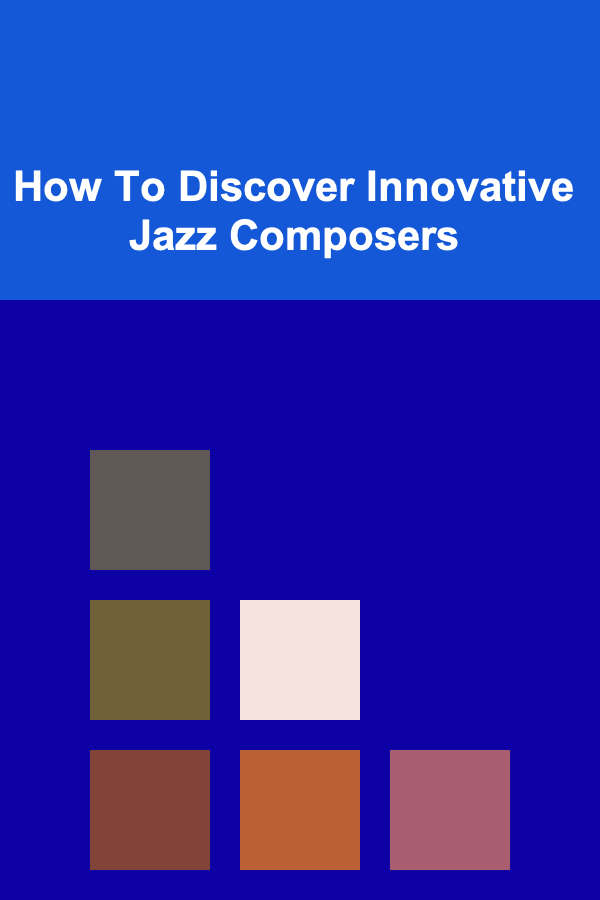
How To Discover Innovative Jazz Composers
ebook include PDF & Audio bundle (Micro Guide)
$12.99$10.99
Limited Time Offer! Order within the next:

Jazz, an evolving and diverse genre of music, has seen a multitude of transformations since its inception in the early 20th century. From its roots in New Orleans to its contemporary sounds that blend elements of electronic, classical, and world music, jazz composers have continually pushed the boundaries of what music can express. Finding innovative jazz composers today involves looking beyond the mainstream and exploring new trends, cross-genre collaborations, and diverse cultural influences. This article delves into how to discover and appreciate these forward-thinking artists who are reshaping the landscape of jazz composition.
Understanding the Evolution of Jazz Composition
To discover innovative jazz composers, it's crucial to first understand the evolution of jazz itself. The genre has constantly reinvented itself, moving through periods of intense experimentation and fusion. Jazz music, at its core, thrives on improvisation, harmonic exploration, and a deep understanding of rhythm. This foundation has allowed composers to break traditional structures and constantly seek new ways to convey emotions, stories, and innovative ideas through their music.
Early Jazz and the Birth of Innovation
Jazz began in the early 1900s, drawing heavily from blues, ragtime, and African rhythms. Early innovators like Louis Armstrong and Duke Ellington laid the groundwork for jazz's future direction. However, the real shift toward innovation happened with artists such as Charlie Parker and Thelonious Monk, whose complex harmonic structures and improvisation techniques challenged the norms of their time. Bebop, the sub-genre that emerged in the 1940s, was characterized by fast tempos, intricate melodies, and sophisticated chord changes. This period set the stage for jazz to become a platform for constant innovation.
The Rise of Modal Jazz and Free Jazz
In the 1950s and 60s, iconic figures like Miles Davis and John Coltrane introduced modal jazz, which moved away from traditional chord progressions, favoring scales or modes as the harmonic foundation. This approach allowed for greater freedom in improvisation and opened the door for even more exploration. Free jazz, pioneered by Ornette Coleman and others, took things a step further by abandoning traditional harmony and rhythm altogether, resulting in music that was highly experimental and sometimes chaotic but deeply expressive.
Fusion and Contemporary Jazz
As jazz continued to evolve, the fusion of jazz with other genres became a hallmark of innovative composition. Artists like Herbie Hancock, Weather Report, and Chick Corea fused jazz with rock, funk, and electronic music, creating a new genre that became known as jazz fusion. Today, contemporary jazz composers are blending jazz with everything from hip-hop and classical music to electronic music and world music, continuously pushing the boundaries of what jazz can be.
Characteristics of Innovative Jazz Composers
Before embarking on the journey of discovering new jazz composers, it's essential to understand the traits that define innovative artists. These musicians are often defined by their willingness to experiment, challenge norms, and approach composition and performance with fresh perspectives.
1. Unique Harmonic Approaches
One hallmark of innovation in jazz composition is the exploration of new harmonic structures. Jazz has long been a genre known for its complex chords and progressions. Innovative composers may break away from traditional harmony, utilizing unusual chord voicings, quartal or quintal harmony, or non-functional harmony. They may experiment with dissonance, creating unexpected sounds that challenge the listener's ear and offer fresh perspectives on jazz's traditional harmonic language.
2. Rhythmic Experimentation
Rhythm has always been a critical component of jazz, but innovative composers play with time signatures, polyrhythms, and syncopation to create more intricate and dynamic rhythms. Some may even abandon traditional beats altogether, exploring unconventional time signatures, shifting meters, or employing irregular rhythmic phrasing. The rhythm section may be deconstructed and reimagined, leading to new textures and grooves.
3. Improvisational Freedom
At the heart of jazz lies improvisation, and innovative jazz composers often push the boundaries of spontaneous creation. They may encourage freer improvisational spaces where musicians are not constrained by set chord progressions or forms. Some composers may even incorporate elements from outside jazz---such as spoken word, noise, or soundscapes---into their improvisation sessions, transforming the solo into a performance of pure expression and exploration.
4. Cross-Genre Influences
In the modern jazz landscape, many composers incorporate influences from various genres and traditions. These influences range from classical music and electronic experimentation to African, Latin, and Middle Eastern rhythms. By fusing disparate elements, these composers create a hybrid sound that is distinctly jazz, but also deeply reflective of the world's diverse musical heritage.
5. Conceptual and Thematic Depth
Many innovative jazz composers focus not just on musical innovation but also on thematic exploration. They may base their compositions around abstract concepts, political statements, or personal experiences, elevating jazz into a form of storytelling or conceptual art. This depth can be seen in albums that push the boundaries of what a jazz record can be, creating a full immersive experience rather than just a collection of songs.
Where to Find Innovative Jazz Composers
1. Exploring Underground and Independent Scenes
One of the most effective ways to discover innovative jazz composers is to venture beyond the mainstream and explore independent music scenes. These artists are often not signed to major labels but create highly original work. Independent music festivals, small clubs, and experimental music venues are excellent places to hear up-and-coming jazz talent. Artists in these spaces may have fewer commercial constraints, allowing them to experiment more freely.
Online platforms like Bandcamp, SoundCloud, and Spotify are also essential for discovering new artists. These platforms often feature independent and emerging jazz composers who share their work directly with listeners. By following these composers and paying attention to genre tags like "avant-garde jazz" or "experimental jazz," you can discover artists who are challenging conventional jazz forms.
2. Jazz Festivals and Concerts
Jazz festivals are a goldmine for discovering innovative composers. Major festivals like the Montreux Jazz Festival, the Newport Jazz Festival, and the North Sea Jazz Festival often feature a blend of established artists and fresh talent. These events allow attendees to experience live performances, where many of the most exciting jazz innovations happen. Additionally, many regional jazz festivals host experimental or avant-garde artists who are pushing the boundaries of jazz.
3. Jazz Education Institutions
Many jazz composers who go on to become innovators start their careers in prestigious jazz programs at universities and conservatories. Institutions like the Berklee College of Music, the Juilliard School, and the New England Conservatory attract top-tier jazz students, some of whom will go on to forge their own unique paths in the jazz world. These schools often have concert series, showcases, and masterclasses where students can present their work to a broader audience. By following these institutions, you can get an early glimpse of future jazz innovators.
4. Social Media and Online Communities
The internet has democratized music discovery, and social media has become a powerful tool for finding new artists. Platforms like Instagram, Twitter, and YouTube allow jazz musicians to share their work, whether through performance videos, studio sessions, or collaborations. Jazz influencers, curators, and critics on platforms like YouTube, Reddit, and Twitter can also help guide you toward the latest jazz trends and composers. Following hashtags like #JazzInnovation or #AvantGardeJazz can help you track down emerging voices.
5. Collaborations and Cross-Genre Projects
Many innovative jazz composers work in collaboration with musicians from outside the jazz world. For instance, some might work with electronic music producers, hip-hop artists, or classical musicians to create hybrid genres that stretch the boundaries of jazz. Keeping an eye on collaborative projects and cross-genre initiatives can lead to exciting discoveries. These collaborations may not always be labeled as "jazz" but often carry the essence of jazz's improvisational and experimental nature.
6. Jazz Radio Stations and Podcasts
Jazz radio stations and podcasts are another great resource for discovering new jazz composers. Many stations, particularly those that focus on avant-garde or contemporary jazz, regularly feature innovative artists. Podcasts like "The Checkout" and "Jazz Night in America" often interview pioneering jazz composers, giving listeners insight into their creative processes and musical visions. Many of these platforms are accessible online, making them an easy and informative way to stay up to date with new releases and composers.
Conclusion
Discovering innovative jazz composers requires both a deep appreciation for the genre's history and a willingness to explore new and unconventional sounds. Whether through independent music platforms, jazz festivals, educational institutions, or cross-genre collaborations, the possibilities for finding new voices in jazz are endless. By following the right channels and being open to musical experimentation, you can uncover the cutting-edge composers who are shaping the future of jazz. As the genre continues to evolve, these innovators will ensure that jazz remains a dynamic and transformative art form for generations to come.

How to Organize Digital Signatures for Business Documents
Read More
How to Plan DIY Science Experiments for Family Learning
Read More
How to Safeguard Your Home While You're at Work
Read More
How To Understand the Role of Reason in Stoic Thought
Read More
10 Tips for Using Python for Statistical Analysis
Read More
10 Tips for a Self-Care To-Do List That Actually Gets Done
Read MoreOther Products

How to Organize Digital Signatures for Business Documents
Read More
How to Plan DIY Science Experiments for Family Learning
Read More
How to Safeguard Your Home While You're at Work
Read More
How To Understand the Role of Reason in Stoic Thought
Read More
10 Tips for Using Python for Statistical Analysis
Read More